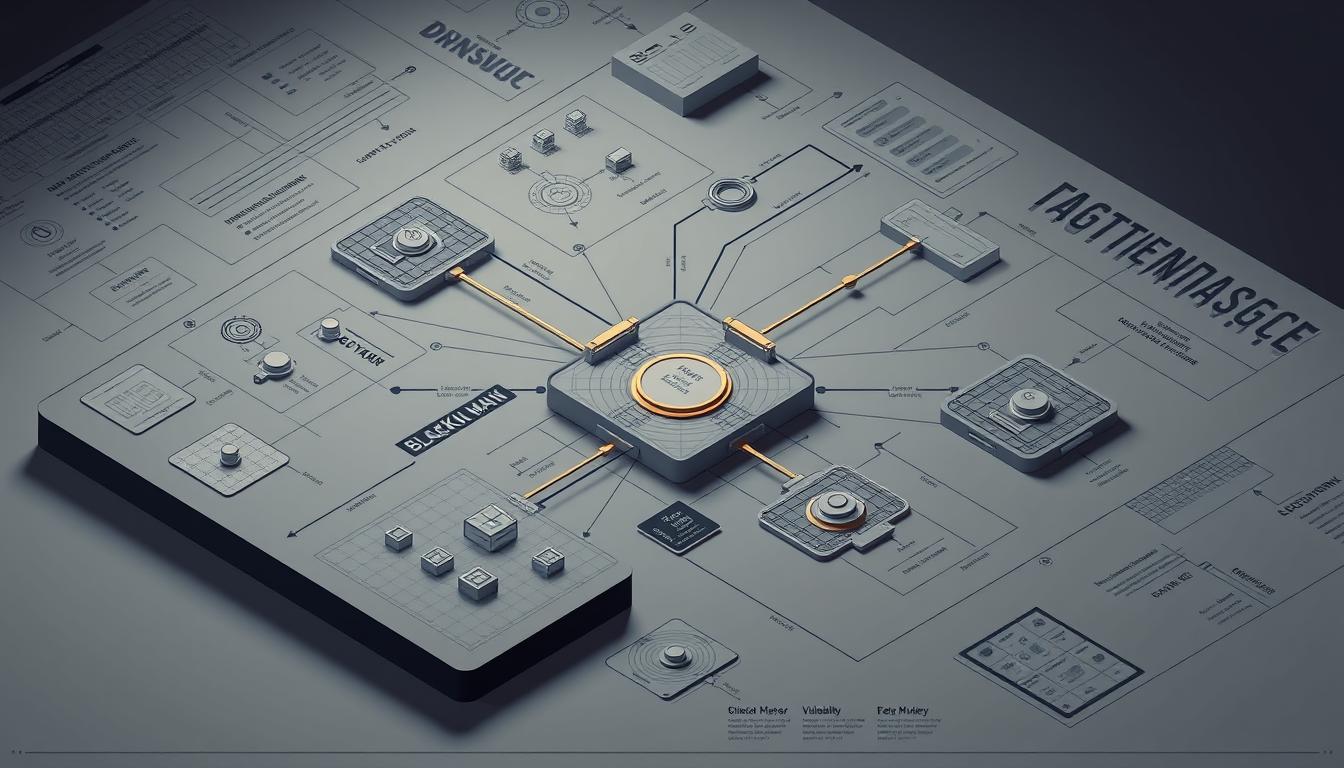Now Reading: Comprehensive Blockchain Audit Security Vulnerability Assessment
- 01
Comprehensive Blockchain Audit Security Vulnerability Assessment
Comprehensive Blockchain Audit Security Vulnerability Assessment

Distributed ledger technology promises a new era of trust and transparency. Yet, this powerful innovation carries unique risks that demand careful attention. A systematic review process is essential for any organization adopting these decentralized systems.
This type of evaluation differs greatly from traditional software checks. It focuses on core components like cryptographic foundations and consensus protocols. Understanding these specialized areas is the first step toward building robust systems.
As adoption grows in finance, healthcare, and logistics, the need for thorough examination increases. Identifying potential weak points protects digital assets and ensures regulatory compliance. It also builds essential trust with partners and users.
This guide will explore the methodology behind a successful evaluation. We will cover the key concepts and steps needed to safeguard your digital infrastructure. Our goal is to provide clear, actionable insights for modern enterprises.
Key Takeaways
- Distributed ledger systems require specialized evaluation methods.
- This process focuses on unique elements like consensus mechanisms.
- Protecting digital assets is a primary goal of any system review.
- Regulatory compliance is a major driver for these examinations.
- Building stakeholder trust is a critical outcome of a successful review.
- Understanding the methodology is key to implementing effective safeguards.
Overview of Blockchain Audit Security Vulnerability Assessment
The integrity of a distributed network relies on a meticulous, multi-layered review process. This overview explains what this evaluation entails and why it is indispensable for businesses today.
Understanding the Concept
A blockchain review is a step-by-step examination of your entire system on a specific network. It aims to detect compliance risks, operational issues, and other errors that could harm the business environment.
This process goes far beyond a simple code check. It scrutinizes the whole ecosystem. This includes nodes, consensus protocols, and transaction mechanisms.
The market for these protective measures is exploding. It’s predicted to grow from $3.15 billion in 2024 to nearly $59 billion by 2032. This reflects a compound annual growth rate of 44.20%.
Importance for Modern Enterprises
Companies face unique challenges that traditional IT frameworks cannot solve. A specialized approach is required for decentralized architectures.
The financial stakes are incredibly high. In 2022 alone, approximately $2.81 billion was lost due to smart contract hacks. This shows the clear financial need for thorough evaluations.
These examinations are not optional. They are essential for protecting digital assets and maintaining operational continuity. They help organizations find problems quickly and secure their networks effectively.
Growing Importance of Blockchain Security Audits
Financial losses from digital platform exploits highlight the critical need for systematic evaluations. Last year alone, hackers stole $739.7 million through phishing and private key theft. This alarming trend shows why protective measures are essential.

Industry Trends and Market Predictions
Recent data reveals an alarming escalation in digital asset theft. Hackers took at least $1.58 billion in just seven months. DeFi scams accounted for 60% of all crypto attacks.
These sophisticated attacks exploit weaknesses in smart contracts and governance structures. The evolution from simple exploits to multi-stage attacks demands more comprehensive approaches.
| Attack Type | Financial Impact | Frequency |
|---|---|---|
| Phishing Scams | $300+ million | High |
| Smart Contract Exploits | $950+ million | Medium |
| Governance Attacks | $330+ million | Growing |
Risks of Inadequate Auditing
Insufficient reviews create substantial dangers for any digital project. Massive financial losses represent just one consequence. Regulatory penalties and legal liabilities can follow.
Reputational damage and loss of user trust can permanently destroy promising initiatives. Investors now demand verified security checks before engaging with new protocols.
The growing complexity of interconnected systems multiplies potential attack surfaces. This elevates the importance of thorough examination processes for long-term success.
Key Elements of a Successful Security Audit
Building resilient distributed networks involves scrutinizing critical elements from code implementation to network architecture. A comprehensive approach examines multiple layers of the digital environment.
Smart Contracts and Code Evaluation
Token agreements written in languages like Solidity form the foundation of many platforms. These digital contracts require meticulous examination to prevent potential issues.
Professional reviewers combine automated tools with manual analysis. They check logic flows, access controls, and mathematical operations. This process identifies weaknesses before deployment.

Infrastructure and Node Security
The underlying network architecture demands equal attention. This includes consensus mechanisms and individual node configurations.
Experts verify proper settings for caching layers and resource limits. They ensure synchronization mechanisms work correctly across the entire system.
Protection against various threats maintains network integrity. This comprehensive evaluation creates a robust operational environment.
Blockchain audit security vulnerability assessment: Process & Best Practices
A systematic methodology is crucial for identifying and mitigating risks within decentralized technology platforms. This approach ensures that every aspect of a project is examined thoroughly, from its initial codebase to its final operational state. Following established procedures is key to building robust and trustworthy systems.
Step-by-Step Assessment Process
The evaluation follows a logical sequence. It starts with project scoping, where teams catalog all relevant code, including smart contracts and node scripts.
Next, automated tools scan for common coding problems. This is followed by a manual review by experts who model potential threats. They check for logic errors and access control issues.
The final phases confirm compliance with regulations and produce a detailed report. This document outlines found problems and suggests fixes.
| Phase | Primary Focus | Key Output |
|---|---|---|
| Project Scoping | Complete system inventory | List of all components to be tested |
| Automated Analysis | Code scanning for known flaws | Initial list of potential concerns |
| Manual Review | In-depth logic and threat analysis | Identification of complex issues |
| Compliance Check | Alignment with legal standards | Verification of regulatory readiness |
| Reporting | Documentation of findings | Actionable plan for remediation |
Security Testing Checklist Implementation
A practical checklist guides the entire evaluation. It begins with understanding the system’s architecture. Teams then detect potential entry points for threats.
This involves collecting configuration data and evaluating contract logic. For a detailed look at this, consider a professional smart contract review.
Best practices emphasize integrating this checking into development workflows. This creates a culture of continuous improvement rather than treating it as a one-time event.
Integrating AI-Driven Tools in Smart Contract Audits
Combining multiple analysis methods, AI-powered systems deliver a more thorough check than manual processes alone. These advanced instruments scan code with incredible speed and accuracy. They help teams find potential issues that are easy to miss.

Static and Dynamic Analysis Techniques
Smart contract reviews now use layered techniques. Static analysis examines the source code without running it. It looks for syntax errors and suspicious patterns.
Dynamic analysis takes a different approach. It runs the contract in a safe, test environment. This shows how the code behaves during real transactions.
Semantic analysis is an even smarter tool. It understands the logic and intent behind the code. This helps find complex, non-obvious problems.
Machine learning models are trained on past exploit data. They can recognize dangerous code signatures. This includes issues like reentrancy or integer overflow.
Automated Report Generation and Insights
After scanning, these tools create detailed reports automatically. The reports list found issues by their severity level. They point to the exact lines of code that need fixing.
This automation saves a massive amount of time. It allows human experts to focus on the most complex logic checks. Tools like MythX, Slither, and Securify are leaders in this space.
The integration of these systems makes the entire process more consistent. It provides comprehensive coverage for any digital agreement project.
Addressing Common Vulnerabilities in Blockchain Networks
Critical weaknesses in automated contract logic create opportunities for malicious actors to manipulate financial operations. These systemic flaws can lead to catastrophic losses if not properly identified and mitigated during development.
Understanding these common issues helps developers build more robust systems. Proper testing protocols are essential for preventing exploitation.

Reentrancy and External Call Issues
Reentrancy attacks represent one of the most dangerous threats to digital agreements. This occurs when malicious contracts make recursive calls before initial transactions complete.
The infamous DAO incident demonstrated how this vulnerability can drain entire liquidity pools. Proper state management before external calls prevents these recursive exploits.
Integer Overflows and Underflows
Arithmetic operations in automated contracts can produce unexpected results when values exceed limits. Integer overflows occur when calculations wrap around maximum values.
Attackers exploit these mathematical errors to corrupt token balances or bypass checks. Using safe math libraries prevents these dangerous arithmetic flaws.
Compliance and Regulatory Considerations
Global data protection laws have transformed compliance from a checkbox exercise into a core operational requirement. Organizations must now demonstrate adherence through comprehensive documentation and verifiable processes.
Thorough system reviews serve a dual purpose. They identify technical issues while generating evidence of regulatory alignment. This documentation creates transparent operational environments that withstand legal scrutiny.
Meeting Legal and Industry Standards
Many jurisdictions now mandate independent verification for digital asset projects. Token offerings and decentralized platforms must prove code integrity before launch. This requirement spans multiple regulatory frameworks.
Key standards include:
- Anti-Money Laundering (AML) requirements
- Know Your Customer (KYC) protocols
- ISO 27001 information security standards
- GDPR data protection regulations
Alignment with established frameworks ensures systematic risk coverage. It addresses all potential entry points that regulators consider material threats. Proper documentation shows organizational commitment to compliance.
The final report must extend beyond technical findings. It should document remediation plans, monitoring procedures, and governance structures. This comprehensive approach meets evolving legal expectations across different regions.
The Role of Crypto Security Audits in Protecting Digital Assets
The automation of financial operations through self-executing contracts requires absolute precision in their underlying code. These digital agreements now form the backbone of modern financial ecosystems.
They handle vast asset volumes across various platforms. Even minor coding errors can lead to significant financial exposure.
Comprehensive verification processes provide essential protection. They identify potential issues before deployment to immutable networks.
| Benefit Area | Primary Impact | Business Value |
|---|---|---|
| Risk Mitigation | Early vulnerability detection | Prevents financial losses |
| Regulatory Compliance | Code integrity verification | Meets legal requirements |
| Investor Confidence | Third-party validation | Builds stakeholder trust |
| Operational Longevity | Pre-deployment testing | Ensures system stability |
Regulatory readiness has become a critical factor. Many jurisdictions now mandate independent verification for token offerings.
Sophisticated investors demand verified contract security before committing capital. This demonstrates professional development practices.
The immutable nature of deployed agreements makes pre-launch examination essential. Once live, modifications become extremely challenging.
These verification processes function as insurance policies for digital assets. They provide both technical and business protection.
Future Trends: AI and Continuous Auditing in Blockchain Security
The next evolution in digital system protection moves beyond periodic checks to constant, intelligent monitoring. This approach uses artificial intelligence to predict risks before they become problems.
Predictive Risk Modeling and Behavioral Analytics
Advanced tools now analyze data from thousands of previous examinations. They identify patterns that might lead to new exploit types.
Behavioral analytics observes how different automated agreements interact during operation. This helps detect unusual activity across connected applications.
For complex platforms like decentralized exchanges, this predictive intelligence provides early warnings. It identifies potential weaknesses before attackers can find them.
Continuous Monitoring and Integration with CI/CD
Continuous examination fundamentally changes the protection paradigm. Instead of one-time assessments, it provides real-time scanning of modified contract versions.
Integration with CI/CD pipelines embeds safety testing directly into development workflows. Every code change gets automatically checked before deployment.
This model supports ongoing management rather than post-deployment response. It alerts teams to anomaly trends across network transactions.
Future tools will use federated learning to share insights without exposing client data. They’ll apply generative AI to simulate attacker behavior and forecast weak points.
Conclusion
As digital assets become increasingly integral to global commerce, systematic verification processes emerge as essential safeguards. These examinations represent more than one-time checks—they function as continuous protection mechanisms.
Effective protection requires a multi-layered approach combining automated tools with expert analysis. This comprehensive methodology addresses the unique complexity of decentralized applications.
Organizations benefit from these processes beyond technical improvements. They gain regulatory compliance, investor confidence, and operational stability. For detailed guidance on implementing these safeguards, explore this professional blockchain security audit methodology.
Proactive investment in thorough system evaluation provides cost-effective insurance against potential threats. It protects both digital resources and business reputation in our security-conscious environment.
FAQ
What is the main goal of a blockchain security audit?
The primary goal is to identify and fix potential flaws in smart contracts and network protocols. This process helps prevent financial losses and protects digital assets from malicious attacks by ensuring the system operates as intended.
How often should a project undergo a security review?
It’s recommended to conduct a full assessment before launch and after any major code updates. For ongoing protection, many teams use continuous monitoring tools integrated into their development pipeline to catch issues early.
What are the most common risks found in smart contracts?
Frequent issues include reentrancy attacks, where an external call can re-enter the contract, and integer overflows that disrupt transaction logic. Proper testing and formal verification help mitigate these dangers.
Can automated tools replace human auditors?
No, automated tools like Slither or MythX are essential for scanning code, but they cannot replace expert analysis. Human auditors provide critical context, understand business logic, and identify complex design flaws that machines might miss.
What should a final audit report include?
A comprehensive report details all found vulnerabilities, their severity level, and specific recommendations for fixes. It also provides a summary of the testing methodology and the overall security posture of the application.
How does a security audit help with regulatory compliance?
A thorough evaluation demonstrates due diligence to regulators. It shows that a project meets industry standards, which is crucial for building trust with users and partners in a rapidly evolving legal environment.















